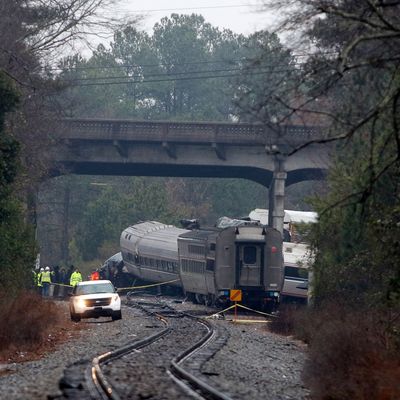
Two people were killed and at least 116 were injured when an Amtrak passenger train slammed into a parked, unmanned freight train in South Carolina early on Sunday morning. It’s Amtrak’s third fatal crash in seven weeks.
The train, which was headed to Miami from New York, hit a CSX freight train loaded with cars near a switchyard about ten miles south of Columbia around 2:45 a.m. It was going an estimated 59 miles per hour.
“It’s a horrible thing to see, to understand what force was involved,” South Carolina governor Henry McMaster told reporters. “The first engine of the freight train was torn up, and the single engine of the passenger train is barely recognizable.”
Amtrak engineer Michael Kempf, 54, of Savannah, Georgia, and conductor Michael Cella, 36, of Orange Park, Florida, were killed in the crash. Both were in the first car of the train. “We should have had a lot more casualties, but we didn’t,” said Lexington County coroner, Margaret Fisher.
The accident raised new concerns about Amtrak’s safety record. In December an Amtrak train derailed in Washington State, killing three people and injuring dozens. The train was going 80 miles per hour, more than twice the speed limit. Just five days ago, an Amtrak train carrying GOP lawmakers to their retreat in West Virginia hit a garbage truck, killing the vehicle’s driver and injuring six others.
Amtrak was quick to blame the freight-rail operator for the crash, saying CSX was responsible for the tracks and signals in the area of the crash, and left a switch in the wrong position, diverting the Amtrak train onto the side track. “CSX had lined and padlocked the switch off the mainline to the siding, causing the collision,” said Amtrak president and chief executive Richard Anderson. CSX said it’s working with investigators, but did not comment on the accusation.
Experts said they believe positive train control technology (PTC), a GPS-based system that can slow or stop trains automatically, could have prevented the crash. As NBC News reports, Amtrak has installed PTC on all of the tracks it owns, mostly in the Northeast Corridor. However, it hasn’t been installed on the more than 100,000 miles of tracks that Amtrak uses, but doesn’t own or operate.
In 2008, Congress passed a law requiring PTC to be installed on all tracks that carry mainline trains by the end of 2015. However, Congress extended the deadline twice. The Federal Transit Authority says 81 percent of railroads are projected to have PTC installed by the new target, the end of 2018. Congress has allowed railroads to apply for yet another extension, which would push the deadline to 2020.
Mark V. Rosenker, a former National Transportation Safety Board chairman, told the New York Times that the recent accidents were the result of a “series of anomalies,” but they may suggest there’s a “lack of safety culture” at Amtrak.
“Accidents are never one thing,” Rosenker said. “They’re a chain of events which come together which create a catastrophic result.”






























